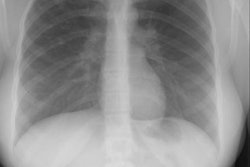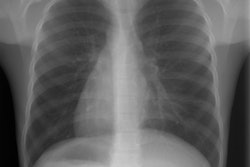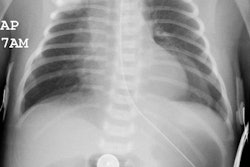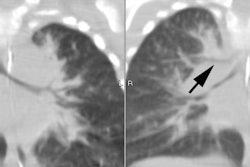Dyskinetic Cilia Syndrome (Kartagener's Syndrome):
View cases of Kartagener's syndrome
Clinical:
Dyskinetic cilia syndrome (DCS) is a genetically heterogeneous, autosomal recessive trait that produces an abnormality in ciliary structure which results in abnormal ciliary motion [3]. This leads to recurrent bronchial infections and subsequently bronchiectasis. The ultrastructural abnormality is related to a deficiency of the dynein arms (which are normally responsible for ciliary bending), absent or short radial spokes (which prevent buckling of the cilia), and absent central microtubules. Classically these patients have chronic rhinitis, sinusitis, otitis, recurrent bronchial infections, bronchiectasis, male sterility, and corneal abnormalities. Abnormalities of thoracoabdominal symmetry with situs inversus totalis or heterotaxy are commonly associated with DCS [3]. Approximately 50% of patients with dyskinetic cilia have Kartagener's syndrome which consists of the triad of situs inversus, bronchiectasis, and sinus disease.X-ray:
Bronchiectasis - particularly involving the right middle lobe and lower lobes - can be seen on CT imaging in 100% of affected adults and up to 56% of affected pediatric patients [3]. Other associated findings include pectus excavatum in up to 9% of patients (excavatum is found in 0.3% of the general population) [3].
REFERENCES:
(1) J Thorac Imag 1995, 10: 256-257
(2) J Thorac Imaging 1995;10(4):268-279
(3) AJR 2007; Kennedy MP, et al. High-resolution CT of patients with primary ciliary dyskinesia. 188: 1232-1238



